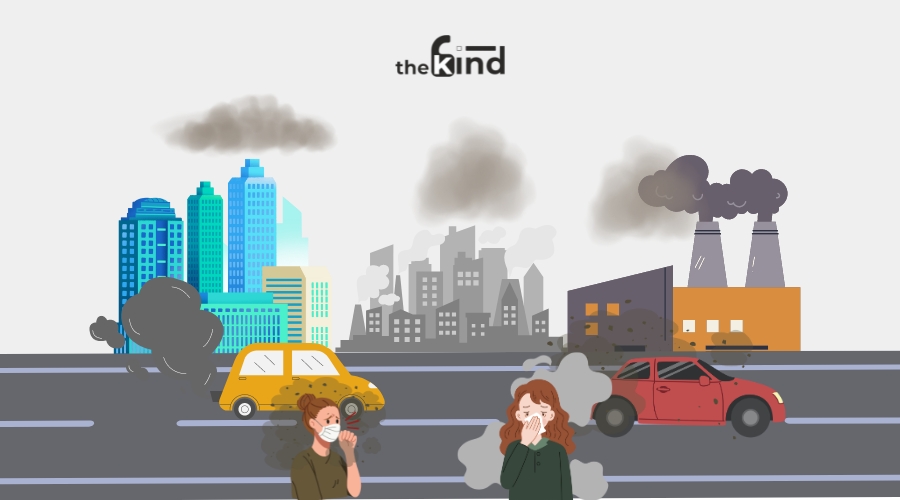Share this
In recent years, the global conversation on planetary health has intensified, driven by mounting evidence of environmental degradation and its profound impacts on human well-being. Air pollution is among the most concerning issues, a silent killer that indiscriminately affects populations worldwide. In the context of India, a country grappling with severe air quality issues, the correlation between air pollution and increased mortality rates has been starkly illuminated by recent studies.
The Lancet Planetary Health Study
A recent study by Lancet Planetry Health showed that even air pollution below current Indian air quality standards leads to increased daily mortality rates in India. The study includes 10 major Indian cities Bengaluru, Ahmedabad, Chennai, Kolkata, Mumbai, Hyderabad, Pune, Shimla, Varanasi, and Delhi.
According to the study, 33000 deaths are annually recorded due to bad air quality exceeding WHO standards. The study’s authors analyzed PM2.5 data and daily mortality counts from 2008 to 2019.
7.2% of these deaths are caused by PM2.5 exposure higher than the WHO value. This estimate doubled when a casual modeling approach excluded the local source of air pollution.
This is notably a very significant study of air pollution in India. It is the very first study that assesses the relationship between short-term air pollution exposure and daily mortality rate across diverse air pollution levels and agro-climatological zones.
A Novel casual modeling technique that excludes the increased impact of local sources of air pollution such as waste burning and vehicle pollution along with others was used in the study.
The Burden of Air Pollution in India
India, with its rapid industrialization and urbanization, has witnessed a staggering deterioration in air quality. Major cities like Delhi, Mumbai, and Kolkata frequently experience hazardous levels of air pollution, primarily due to vehicular emissions, industrial activities, construction dust, and biomass burning. This toxic air cocktail consists of particulate matter (PM), nitrogen dioxide (NO2), sulfur dioxide (SO2), ozone (O3), and volatile organic compounds (VOCs), posing significant health risks to millions of people exposed to it daily.
Recent findings
A recent comprehensive study on planetary health, focusing on India’s air pollution crisis, has brought alarming findings to light. Researchers have meticulously analyzed data correlating elevated levels of particulate matter (PM2.5 and PM10) with increased mortality rates. PM2.5, particles smaller than 2.5 micrometers in diameter, are particularly pernicious as they can penetrate deep into the lungs and enter the bloodstream, leading to a myriad of health complications.
Linking Pollution to Mortality Rates
The study found a direct relationship between prolonged exposure to high levels of PM2.5 and PM10 and a rise in mortality rates across different demographic groups in urban and rural settings. Respiratory diseases such as chronic obstructive pulmonary disease (COPD), asthma, and lung cancer are prevalent among those living in highly polluted areas. Cardiovascular ailments, including heart attacks and strokes, also show an alarming uptick in incidence correlated with air pollution levels.
Regional Disparities and Vulnerable Populations
India’s air pollution crisis exacerbates existing health inequities, disproportionately affecting vulnerable populations such as children, the elderly, and those with pre-existing health conditions. Rural areas, despite lower overall pollution levels compared to urban centers, face unique challenges due to indoor air pollution from biomass burning for cooking and heating.
Policy Implications and Calls to Action
In response to the mounting evidence linking air pollution to adverse health outcomes, policymakers and public health officials in India are under increasing pressure to implement stringent air quality standards and enforce regulatory measures. Initiatives promoting renewable energy sources, electric mobility, and sustainable urban planning are gaining traction but require concerted efforts from all stakeholders – government bodies, industry leaders, healthcare professionals, and communities.
Conclusion
The study underscores the urgent need for decisive action to mitigate the impacts of air pollution on public health in India. While awareness campaigns and advocacy efforts raise public consciousness, translating these into effective policy measures remains paramount. Addressing the root causes of air pollution through innovative technologies and sustainable practices is crucial not only for safeguarding human health but also for preserving the planet’s ecological balance.
As India grapples with its air quality crisis, the findings of this study serve as a poignant reminder of the interconnectedness between environmental health and human well-being. Concerted efforts today will determine the quality of life for future generations, underscoring the imperative for global solidarity in tackling the multifaceted challenge of air pollution and advancing planetary health.

